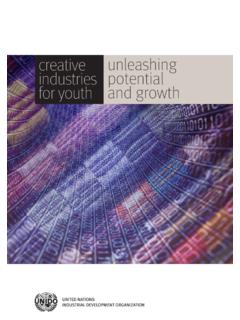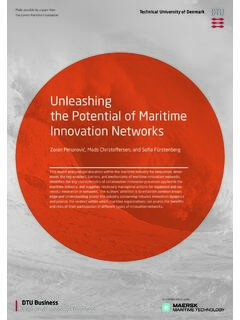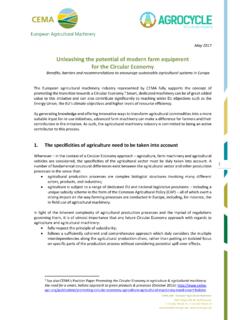Transcription of Unleashing leadership potential:: Toward an evidence-based ...
1 Unleashing leadership potential : Toward an evidence-based management ofemotional intelligenceFrank Walter, Ronald H. Humphrey, Michael S. ColeSergey Brin and Larry Page, the two co-founders of Google,drew on their mathematical brilliance to create the innova-tive algorithm behind Google s search engine. Forced tocompete against already well-established Internet searchproviders (like Yahoo and AltaVista), however, Brin and Pagerecognized that this was not enough. Without an inspired,highly motivated workforce, their burgeoning new venturewould ultimately fail to outshine competitors. So how didGoogle attain the unique position it holds today?
2 We believethis is due in part to Sergey Brin and Larry Page semotional intelligence. To guide the company during initialgrowth and development, for example, they selected anexperienced business leader, Eric Schmidt, as chief executiveofficer, or CEO (Larry Page just recently took over the CEOposition from Eric Schmidt). Like Brin and Page, the newlyappointed CEO valued open emotional expression. Together,the trio created an emotionally supportive culture thatencourages employees to express who they are as individualswhile engaging in creative, innovative behavior. Further-more, the founders of Google have shown empathy towardboth employees and society at large.
3 Google has, accordingly,been ranked as high as number one in national employeesatisfaction surveys. Also Brin and Page founded their charity, , at the time of their initial public offering ofstock. All in all, its founders qualities in terms of bothcognitive and emotional intelligence have helped Googledevelop a uniquely innovative, entrepreneurial, and stimu-lating few other business concepts, the notion of anemotionally intelligent leader has caught the interest andstirred the imagination of scholars and practitioners authors have gone so far as to proclaim emotionalintelligence as the sine qua non of leadership , arguingthat emotional intelligence accounts for up to 90 percentof the difference between star performers and averageperformers in senior leadership positions.
4 Fueled by suchclaims, a multi-million dollar industry has emerged, offering off the shelf applications designed to improve one s emo-tional intelligence. As an example, we conducted an Internetsearch based on the terms emotional intelligence and leadership . This search yielded over million online retailer, , offers more than 280 booksbased on the same search terms!On this basis, it is safe to assume that emotional intelli-gence is a viable concept grounded in solid, scientificevidence Right? Actually, the jury is still out withfew other ideas having created as much controversy inthe academic business community. Whereas some havepraised the relevance of emotional intelligence for success-ful leadership , others continue to question its very exis-tence.
5 John Antonakis from the University of Lausannehas criticized, for example, that practice and voodooscience may be running ahead of rigorous research inthe field of emotional intelligence and leadership . From apractical perspective, this controversy around emotionalintelligence is highly undesirable, raising more questionsthan it answers. Can one reasonably expect emotionallyintelligent leaders to perform more effectively or isemotional intelligence just another empty managementfad? Are companies well advised to incorporate emotionalintelligence into their leader selection, promotion, anddevelopment efforts or should they focus on other, morepromising concepts?
6 We aim to provide answers to these questions. To do so, wefirst address an underlying cause of the current we will show, people use the same term emotionalintelligence to talk about strikingly different things. Wethen review the empirical evidence, highlighting recentfindings on the role of emotional intelligence for job perfor-mance and leadership . To conclude, we sketch a foundationOrganizational Dynamics (2012) 41, 212 219 Available online at ur n al h o mep ag e: www .elsevier .co m /loc ate/o r gd yn0090-2616/$ see front matter # 2012 Elsevier Inc. All rights an evidence-based management of emotional intelligencein organizational IS EMOTIONAL INTELLIGENCE?
7 A BRIEFREVIEW OF CONFLICTING PERSPECTIVESE motional intelligence is a complex phenomenon. Indeed,despite a large body of research and a wide range of practicalapplications, there is little consensus about its true in the early 1990s, John Mayer and Peter Salovey sseminal research sparked interest in the concept. Mayer andSalovey view emotional intelligence as a set of four specific,interrelated abilities (or branches ) that help people toeffectively deal with their own and others emotions. First,the ability to perceive emotions allows an emotionally intel-ligent person to correctly identify the emotions he or sheexperiences and to accurately recognize others ability helps people, for example, to decipher theemotions expressed in others faces.
8 Second, the ability touse emotions is based on knowledge about how feelingsinfluence one s thinking. This branch enables people toeffectively utilize their emotions to facilitate problem-sol-ving. Third, the ability to understand emotions helps anindividual to grasp the causes and consequences of emotionsand to comprehend how emotions develop over time. Andfourth, the ability to manage emotions is about regulatingone s own and others feelings to better attain specific final branch helps people, for example, to effectivelycontrol their anger. John Mayer and his colleagues havedeveloped the Mayer-Salovey-Caruso Emotional IntelligenceTest (MSCEIT) to measure each of the four branches ofemotional intelligence.
9 Akin to classic IQ tests, the MSCEIT incorporates questions with right and wrong answers to assessone s emotional Mayer and Salovey s work drew considerableattention, emotional intelligence became widely popularthrough journalist Daniel Goleman s best-selling book Emo-tional Intelligence. The ideas presented in this book made itonto the cover of Time Magazine, and they are mirrored inmany practical applications. This enormously popularapproach, however, is strikingly different from how emo-tional intelligence was initially conceived. Besides emotionalabilities, this alternative view covers a wide array of per-sonality traits, self-perceptions, and other attributes.
10 Forexample, the Emotional Competence Inventory (ECI) a 360-degree questionnaire based on Goleman s model ofemotional intelligence covers four broad clusters withnumerous underlying competencies. The self-awarenesscluster includes emotional self-awareness, accurate self-assessment, and self-confidence; the self-management clus-ter includes emotional self-control, transparency, adaptabil-ity, achievement orientation, initiative, and optimism; thesocial awareness cluster includes empathy, organizationalawareness, and service orientation; and the relationshipmanagement cluster includes developing others, teamworkand collaboration, conflict management, change catalyst,inspirational leadership , and influence.









